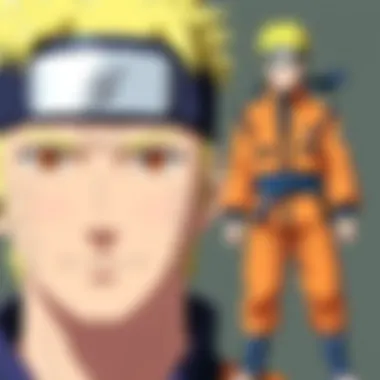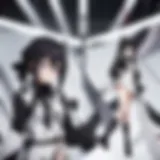Exploring the Impact of Naruto Shippuden's First Dubbed Episode


Prolusion to the Series
Naruto Shippuden is the captivating sequel to the widely acclaimed series Naruto, bridging the gap between the carefree days of youth and the weightier responsibilities of adulthood. It belongs to the shonen genre, primarily aimed at young male audiences. This anime began airing in Japan on February 15, 2007, running for a total of 500 episodes until its conclusion in 2017. Adapted from Masashi Kishimoto's original manga, which first serialized in 1999, the series has garnered an impressive following, evolving from a simple tale of a young ninja’s dream into a complex narrative of growth, conflict, and redemption.
The background context of Naruto Shippuden lies firmly in its predecessor. After a two-and-a-half-year time skip, we find Naruto returning to the Hidden Leaf Village, now a more mature character, shaped by hardships and losses. The adult themes explored here, such as friendship, sacrifice, and the pursuit of one's dreams, resonate with a broader audience, allowing the series to transcend typical shonen fare.
As for its popularity, the series has achieved cult status not just in Japan but globally. Critical reception has acknowledged its deep narrative arcs and character depth, while fans rave over its action-packed sequences and intricate world-building. Its unique blend of humor, tragedy, and high-stakes conflicts makes it a staple in the anime community, appealing to both seasoned fans and newcomers alike.
Staff and Cast Details
The successful adaptation of Naruto Shippuden can be greatly attributed to a talented team behind the scenes. Directed by Yasuharu Takanashi, who also composed the series' remarkable score, his direction balances intense action with emotional resonance.
Writers like Katsuyuki Sumisawa played a crucial role in tailoring the story for the audience, ensuring that critical elements of the source material were retained while still appealing to new viewers.
Here are some key staff members:
- Director: Yasuharu Takanashi
- Script Writer: Katsuyuki Sumisawa
- Character Designer: Tetsuya Nishio
On the voice acting side, Naruto Shippuden's dub features some prominent figures in the industry. Maile Flanagan lends her voice to Naruto Uzumaki, bringing both energy and depth to the character. Other notable performances include Yuri Lowenthal as Sasuke Uchiha and Laura Bailey as Sakura Haruno.
Behind the scenes, the studio Pierrot managed the animation, infusing each episode with a vivid and dynamic visual presentation that complements the story.
Theme Music Analysis
The sound of Naruto Shippuden is just as vital as its storytelling. The opening theme for Episode 1, "Hero's Come Back!!" by Yusuke Nakamura, sets the stage with its energetic beat and inspiring lyrics. It encapsulates Naruto’s determination and serves as a rallying cry for his journey ahead.
Meanwhile, the ending theme, "Tobira no Mukou e" by Ayaka, offers a contemplative juxtaposition to the opening, presenting themes of hope and looking forward. This emotional connect hits hard, showcasing the contrasting highs and lows of Naruto's world.
The music involved lots of creativity and talent:
- Opening Theme: "Hero's Come Back!!" - Yusuke Nakamura
- Ending Theme: "Tobira no Mukou e" - Ayaka
In summary, the musical elements in Naruto Shippuden are not mere background noise but integral to its storytelling, enhancing viewers’ emotional engagement with the series.
Plot Summary and Analysis
In the first episode of Naruto Shippuden, the narrative resumes shortly after the original series left off. Our protagonist, Naruto, returns to his village after extensive training and immediately faces a more serious conflict. In this debut, viewers witness the introduction of new characters and the evolution of existing ones. The episode effectively sets the tone, showcasing Naruto’s growth while hinting at larger arcs to come, such as the threats posed by the Akatsuki.
Plot-wise, the episode is compelling as it addresses themes of resilience and the weight of expectations. The animation team uses effective storytelling techniques, employing visual cues and dialogue to create an atmosphere saturated with anticipation. Certain motifs, like the bonds of friendship and the ongoing struggle against adversity, swim into the forefront, giving fans both nostalgia and excitement for what lies ahead.
Critical insights reveal how the pacing is meticulously crafted. Moments of intense action intermingle with reflective beats that explore the emotional landscapes of the characters. The narrative structure grips the viewers, leaving them longing to see how the story will unfold.
Reception and Impact
Upon its release, Naruto Shippuden Episode 1 received a warm reception from both critics and fans alike. Reviewers praised its faithful adaptation while highlighting the nuanced character development and the elevated animation quality.
The significance of this anime extends beyond its episodes. With a rich cultural impact, it has influenced a generation of viewers and creators, prompting discussions around themes of identity and belonging. Its legacy can be seen in various media, including spin-offs, merchandise, and a dedicated fanbase that actively engages on platforms like Reddit and Facebook.
When compared to other anime in the shonen genre, Naruto Shippuden holds a special place due to its intricate plot and character complexity. While many series rely on formulaic storytelling, Naruto Shippuden pushes boundaries, exploring darker themes and moral dilemmas.
"Naruto Shippuden isn’t just a show; it’s an emotional journey that resonates with anyone who has ever dared to dream."
In summation, this first episode marks a significant return, not just in animation but in shared experiences and cultural conversations that continue to thrive in fandom today.
Prologue to Naruto Shippuden
The significance of Naruto Shippuden cannot be overstated in the realm of anime. This series marks a notable evolution from its predecessor, Naruto, steering the narrative into deeper waters and complex character arcs. The journey from childhood innocence to the struggles of adulthood is something that resonates with viewers across the globe. The first English dubbed episode, in particular, serves as a vital entry point for many fans.
By digging into this transition, we can appreciate how the dub attempts to capture the essence of the original Japanese version while making it accessible to a broader audience. This balance holds a dual importance; not only does it maintain the integrity of the story, but it also caters to the nuances of a new culture. Analyzing this first episode offers insight into character dynamics, emotional depth, and the foundations for future storytelling.


Setting the Scene
The opening scene of Naruto Shippuden is crucial for setting the tone of the series. From the outset, viewers are presented with a world that has evolved; the once familiar village of Konohagakure is now shrouded in a sense of impending conflict and growth. The contrast between what once was and what now is speaks volumes. The animation and soundtrack pull the viewer in, presenting a matured version of what they loved in the original series.
As the dust settles from the passing of years, we are introduced to older versions of beloved characters like Naruto Uzumaki and Sakura Haruno. This scene is marked by an almost somber yet hopeful tone, illustrating that time has significantly affected our heroes. The stakes are raised, and uneasiness looms large, creating an atmosphere ripe for intrigue. The audience quickly senses that the events that will unfold carry weight and consequence.
Transition from Naruto to Naruto Shippuden
Understanding the shift from Naruto to Naruto Shippuden is like flipping a page in a gripping novel. The narrative picks up after a time skip, which is less about merely continuing the story and more about showcasing character evolution. The transition addresses how childhood friendships evolve under the pressure of adversity.
For those who enjoyed the earlier series, this progression highlights the transformation of the characters in significant ways. Naruto emerges more determined, not only to become Hokage but to connect with those around him. Meanwhile, Sakura is shown as more than just a support character; she is stepping into her own, willing to face the challenges that lie ahead.
This careful setup is important to grasp as it prepares audiences for the trials and tribulations that the characters will face. The narrative builds anticipation, hinting at both personal and communal challenges that will color the episodes to come.
Overall, this introductory examination sets the foundation for a rich analysis of the dubbed series, emphasizing its unique role in bridging cultural divides and shaping a legacy within the anime landscape.
Overview of Episode Dub
The analysis of the first English dubbed episode of Naruto Shippuden serves as a crucial pivot in understanding not just the narrative flow, but also how Western audiences engaged with an established universe. This section delves into the specifics, evaluating how the dub set the groundwork for character arcs, thematic depth, and cultural resonance amongst fans. The importance of the Overview of Episode 1 Dub cannot be understated, as it lays the foundation for how the series would be perceived and received by its new audience.
Episode Synopsis
The story picks up a few years after the original Naruto series concludes, shifting the tone and stakes considerably. The opening episodes introduce us to a world where familiar characters have matured, physically and mentally. The plot begins with a bleak atmosphere permeating the Hidden Leaf Village, indicating the gravity of the challenges ahead. Naruto, now a young adult, returns from training with Jiraiya, only to find that much has changed. The village is on high alert due to the resurgence of the Akatsuki, a formidable organization with insidious intentions.
This divergence places Naruto firmly into the fray, as he navigates new threats alongside his comrades. The episode succinctly establishes its premise: the struggle between past sacrifices and future hopes. The dub effectively captures not just the storyline but the emotional weight of Naruto's reunion with friends and mentors, ensuring that both new viewers and old fans grasp the significance of these encounters.
Key Characters Introduced
The first episode effectively reintroduces several key figures, each having evolved since the original series.
- Naruto Uzumaki has transformed from the impetuous child into a determined and focused ninja. His longing for acknowledgment and connection remains palpable.
- Sakura Haruno showcases her growth as a skilled kunoichi, illustrating the strength and confidence she has gained in Naruto's absence.
- Kakashi Hatake returns with a calmer demeanor, reflecting on the weight of leadership and mentorship as he guides the new generation.
- Pain, as the new chief antagonist, enters the scene with an ominous presence, underscoring the looming threat that drives the narrative forward.
These characters' reintroductions aren’t mere nostalgia trips; they serve vital narrative purposes, connecting the audience to the larger conflict unfolding shortly. Each character embodies specific themes that resonate throughout the episode, setting the stage for complex dynamics and emotional arcs.
Setting and Atmosphere
The setting of Naruto Shippuden plays a pivotal role in distinguishing it from its predecessor.
Key Elements of Setting:
- Visual Tone: The animation style adopts a more mature and polished aesthetic, submerging viewers in a world fraught with intense feelings.
- Sound Design: The score reflects the darker themes of the series, enhancing dramatic moments while complementing character interactions.
- Cultural Elements: Public spaces in the Hidden Leaf Village illustrate both the community's resilience and the impact of current events on their everyday lives. This backdrop amplifies the stakes of the narrative as it highlights the bond between characters and their shared history.
Overall, the setting effectively establishes a heightened sense of urgency that runs throughout the episode. The tension is palpable as characters navigate their pasts amid present threats. Notably, the dub captures these nuances well, ensuring the essence of the original series while presenting it in a way that resonates with a wider audience.
"Naruto Shippuden redefines the stakes for its heroes while painting a picture of a world that is both familiar and unsettlingly changed."
Through a well-crafted synopsis, the reintroduction of key characters, and a compelling atmosphere, the episode successfully weaves its narrative threads into a fabric that holds the audience's attention, ensuring they are invested in the unfolding story.
Dubbing Techniques and Choices
In the realm of anime, dubbing is a pivotal component that bridges cultural divides, allowing content to resonate with a broader audience. The first episode of Naruto Shippuden's English dub not only serves as an introduction to a beloved series but also exemplifies the nuances involved in the dubbing process. The techniques and choices made by the dubbing team have significant ramifications on audience perception, emotional engagement, and fidelity to the original narrative.
The importance of this section lies in understanding how voice casting, character voice matching, and cultural localization strategies converge to create an experience tailored for English-speaking audiences. Each choice can enhance or detract from the storytelling, making it essential to dissect these aspects with care.
Voice Casting Decisions
Casting decisions are foundational to any dubbing project. For the English dubbed version of Naruto Shippuden, the selection of voice actors was not merely a matter of finding those who could pronounce lines correctly; it was about capturing the essence of each character. For instance, the choice of Maile Flanagan to voice Naruto Uzumaki has been praised for her ability to convey both the youthful exuberance and the emotional turmoil that define him throughout the series.
By picking actors who not only bring their characters to life but who also share some personality traits or emotional ranges, the dubbing team aims for a seamless immersion into the narrative. The casting of Yuri Lowenthal as Sasuke Uchiha, who is known for his capability to deliver both somber and action-oriented lines with equal fervor, adds a layer of depth. The right voice can turn a mere character into a relatable figure, stirring feelings in viewers—a delicate art that requires both intuition and experience.


Character Voice Matching
Closely tied to casting, character voice matching refers to the alignment between the voice actor’s performance and the character's established traits. When anime is originally produced, the voices are crafted to fit the character's personality. For instance, Naruto's spirited nature required a voice that could convey high energy and determination. Conversely, a character like Sakura Haruno required a voice that could express a wide range of emotions—strength, vulnerability, and growth.
In the English dub, the performers rose to the occasion, skillfully matching their vocal tones to the distinctive personalities and emotional arcs. This aspect is what keeps an audience captivated and forms a connection as they continue to follow the characters' journeys. Ensuring that these voices resonate with the established character traits is a fine balance that demands skill from the voice actors, making it integral to the listening experience.
Cultural Localization Strategies
Dubbing isn't just about translating words; it’s about conveying meaning in a way that resonates with the target audience's cultural context. Cultural localization involves adapting dialogues, jokes, and references to fit the norms and expectations of an English-speaking audience. For example, while Naruto's original lines may reference specific Japanese cultural elements, the English dub often reworks these lines to enhance relatability.
This means tuning in to the local culture's nuances without losing the essence of the characters or plot. The skillful adaptation of slang, idiomatic phrases, and cultural references is essential. It can engage audiences more effectively, allowing them to connect with the series on a personal level.
The interplay between keeping characters true to their roots while adjusting their dialogue for local understanding is a challenge that requires both creativity and cultural insight.
"A good dub should feel like a conversation—one where the characters are speaking to you, not just delivering lines."
Overall, each of these dubbing techniques and choices plays a pivotal role in establishing Naruto Shippuden's identity in the English-speaking market. They are not merely logistical decisions but artistic collaborations that breathe life into the series, ensuring that it remains a beloved staple among fans everywhere.
Narrative Analysis
The narrative analysis of Naruto Shippuden Episode 1 Dub is key in understanding how the series reestablishes its thematic core and character arcs from the original Naruto. This episode is more than just a follow-up; it serves as a strategic reset, drawing both seasoned viewers and newcomers into a complex world where old friendships are tested, and new challenges arise. In this analysis, we dive into essential elements that shape the narrative, such as themes, character development, and the foreshadowing of impending conflicts.
Theme Exploration
At its heart, the first episode of Naruto Shippuden is steeped in the themes of resilience, friendship, and the struggle for identity. The episode emphasizes growth, not just in terms of strength, but in the characters’ emotional and personal journeys. Sasuke's absence is felt deeply, and Naruto's determination to bring him back highlights a fundamental theme of loyalty. The burden of a promise looms large, as Naruto grapples with the responsibility of returning his friend. This is not merely a personal quest but resonates with the broader theme of bonds—how they shape individuals and catalyze change.
The introduction of pain and trauma is also evident, reflecting on how war and hardship impact the psyche. It's a stark reminder that even in pursuit of one’s dreams, the shadows of the past may chase them. Such thematic elements are distillations of the narrative's essence, exploring what it means to be a hero within the chaos of shinobi life.
Character Development in Episode One
In this initial episode, character development takes center stage, particularly for Naruto Uzumaki. His evolution from an outcast to a valued ninja is palpably illustrated. As he stands in the aftermath of his previous ventures, we see a more mature Naruto, yet still haunted by past failures. He is driven by a fierce need to prove himself—not just to others, but to himself. This self-reflection marks a critical growth point in his journey.
In contrast, we have Sakura Haruno, who emerges not only as a supportive figure but also as a more capable ninja, reflecting on her training during Naruto's absence. Her ambition is showcased, indicating her own growth and foreshadowing her role beyond just a romantic interest. There’s also Kakashi Hatake, whose enigmatic demeanor and subtle hints of wisdom set the stage for his mentorship, cementing his significance in Naruto’s development.
This deepening of character dimensions is crucial, as it sets nuanced stakes for the narrative moving forward. Every character introduces a layer, intertwining personal motivations with overarching themes, which helps create a rich tapestry of interactions that feel authentic.
Setting Up Future Conflicts
As the first episode unfolds, it meticulously plants the seeds for conflicts that will echo throughout the series. Tensions arise not just from external villains like the Akatsuki, but also from internal struggles within the characters. Naruto’s pursuit of Sasuke isn't merely about physical confrontation; it symbolizes the struggle against adversity and the darker aspects of human nature, such as revenge and loss.
Moreover, glimpses into the new threats facing the Hidden Leaf Village hint at cataclysmic challenges ahead. Characters like Deidara and other members of the Akatsuki are subtly introduced, showcasing that they are not just one-dimensional foes but reflect the complexities of the world Naruto inhabits. Broken relationships and unresolved pasts will culminate in tragic confrontations, thus preparing the audience for emotional stakes that extend far beyond mere combat.
In essence, the episode serves as a sprawling introduction to new alliances, rivalries, and unresolved tensions, setting the stage for multifaceted conflicts. It showcases how individual motives intertwine with larger societal issues, ensuring that the narrative feels weighty and resonant.
"In the evolution of Naruto's narrative, every episode serves as a stepping stone, leading to personal and collective challenges that are as much about the heart as they are about the fight."
Through a thorough examination of these elements, we gain greater insight into how Naruto Shippuden articulates its story. These layers of analysis are pivotal for fans and those interested in narrative structure, as they reveal the underlying themes and character dynamics that drive the series forward.
Audience Reception
Understanding the audience reception of the English-dubbed episode of Naruto Shippuden is crucial. It reflects not only how well the show resonates with its viewers but also the broader implications of translation and adaptation in cultural contexts. The journey from the original Japanese anime to its English dub is a significant leap, and how fans perceive this transition says a lot about both the audience's expectations and the industry's standards. Audience reactions can offer insights into the effectiveness of dubbing as a medium to convey the original narrative, character intentions, and emotional depth of the series.
Initial Reactions to the Dub
When Naruto Shippuden first aired in the English dub format, the reactions were varied but profoundly telling. Many long-time fans of Naruto had likely followed the story from its inception in the original series. For them, hearing familiar characters with different voices was akin to rearranging the furniture in a beloved room; something felt off, though they often couldn't pin down precisely why.
New viewers, however, approached the series without preconceived notions. They responded to the character dynamics and the storyline without the weight of nostalgia. Many fresh fans found themselves unexpectedly engrossed, drawn in by the animation and the emotional stakes. According to a mix of reviews on platforms like Reddit, there was a palpable excitement as audiences geared up for this new chapter. Some noted, "The animation quality is still stunning, and the action sequences feel just as intense with the new voices."


Yet, not all initial feedback was glowing. Comments on social media highlighted disappointments with certain voice actors, citing mismatched tones or delivery that didn't quite translate the essence of the original performances. These critiques were often expressed with a keen awareness of the challenges in matching the energy and nuance of Japanese voice acting, revealing the audience's high expectations.
Critiques of Adaptation Choices
As the dust settled, critics and fans alike began to dissect the adaptation choices that influenced the final product. Some of the most poignant critiques revolved around the cultural localization strategies. The English dub chose to reposition certain phrases and idiomatic expressions that hold significance in Japanese. While this was intended to make the dialogue more relatable for English speakers, it led to pushback from purists who felt that some characters lost their original flair and charm.
Moreover, key scenes that were pivotal in setting emotional tones faced the brunt of critique. For example, the line delivery during critical moments can occasionally feel dulled compared to the Japanese version. Notably, in forums and review sites, users mentioned specific instances where emotional depth was either amplified or diluted through performance choices:
- Voice Actor Performance: Some performances were commended for hitting the right notes, while others were criticized for failing to capture essential emotional highs and lows.
- Script Changes: Certain changes in the script, aimed at cultural relevance, did not sit well with die-hard fans, who voiced frustrations about losing the original sentiment of pivotal lines.
While adaptation is essential, critics argue that it should never overshadow the source material's essence. This sentiment echoed throughout various platforms, highlighting the balancing act between staying true to the original content and achieving accessibility.
Comparison with Subtitled Version
The comparison between the dubbed and subtitled versions plays a significant role in audience reception. Subtitled versions often maintain a closer fidelity to the original script, allowing nuances in language and culture to shine through. Fans who opted for subtitles claimed that it felt more authentic, preserving not just dialogue but also cultural nuances inherent in the Japanese language.
On the other hand, the dubbed version, while offering accessibility to a broader audience, often garners criticism for its pacing and dialogue flow. Rapid English speech sometimes detracted from solemn moments, causing some viewers to feel disconnected.
This contrast has led to lively debates in fan communities, where discussions often spiral into:
- Accessibility: Many recognize the merit of the dub in reaching non-Japanese speakers, ushering in new fans.
- Cultural Integrity: Critics argue that relying on subtitles allows for a more genuine experience, where the essence of the culture is more palpable.
Cultural Impact of Naruto Shippuden
The cultural impact of Naruto Shippuden extends far beyond the realm of animation and fandom. This series not only redefined the landscapes of anime but also rippled through various aspects of popular culture. Recognizing its significance offers valuable insights into how storytelling and character development resonate with audiences globally. This section will explore various dimensions, shedding light on the specific element of cultural impact expressed through Naruto Shippuden.
Influence on Anime Dubbing Industry
The reception of the Naruto Shippuden dub showcases how this series played a pivotal role in shaping the standards and practices within the anime dubbing industry. Before its release, English-dubbed anime often faced criticism for poor localization choices or mismatched voice performances. However, Naruto Shippuden elevated expectations. It pushed the envelope by incorporating talented voice actors who strived to capture the essence of the original characters.
- Professionalism: Voice actors brought a level of professionalism that was not as prominent prior. For instance, the role of Naruto was voiced by Maile Flanagan, whose performance added layers to the character that many fans appreciated.
- Nuanced Localization: The show's adaptation went beyond mere translation. Key cultural references were thoughtfully localized, making them relatable to a Western audience. This practice has become a benchmark for future dubs.
- Industry Standards: Following Naruto Shippuden, other anime companies took note, recognizing the importance of quality dubbing. This spurred a wave of investment in voice talent and better scripts, ultimately enriching the viewing experience for audiences.
Contribution to Global Popularity of Anime
The impact of Naruto Shippuden is unmistakable when looking at its role in popularizing anime worldwide. It emerged during a time when anime was gaining a foothold in Western markets, and the Naruto franchise served as a substantial bridge. Its success can be attributed to several factors:
- Relatable Themes: Themes such as friendship, perseverance, and overcoming adversity struck a chord with viewers of all ages. Naruto’s journey of growth resonated universally, enabling a connection between diverse cultural backgrounds.
- Merchandising and Media Presence: The franchise didn't limit itself to television; it sprawled into merchandise, video games, and even movies. This multifaceted presence ensured Naruto had a sustained visibility that other series struggled to achieve.
- Fandom and Communities: Online communities around Naruto Shippuden flourished, fostering discussions and fan art. Forums like Reddit and fan pages on Facebook became hotbeds for engagement, allowing fans to share their thoughts on episodes and character arcs.
Enduring Legacy of the Series
Naruto Shippuden has left an indelible mark on both its fans and the anime industry itself. Its legacy is felt in the themes it tackled, the complexity of its characters, and the artistic storytelling it employed.
- Innovation in Storytelling: The narrative structure employed in Shippuden—which included character backstories and profound moral dilemmas—has influenced the approach of newer anime series. This complexity adds depth to characters, prompting viewers to invest emotionally.
- Inspiration for Creators: Countless manga artists and anime creators cite Naruto Shippuden as a source of inspiration. The determination emphasized through characters like Naruto and Sasuke has encouraged many to pursue their creative ambitions.
- Cultural Exchange: Lastly, Naruto Shippuden acted as a conduit for cultural exchange, introducing audiences to Japanese customs, philosophies, and values. This sharing of culture adds to its timeless appeal.
Understanding the impact of Naruto Shippuden invites us to appreciate the depth of anime as an art form that transcends mere entertainment. Its influence in shaping modern anime dubbing practices places it at the forefront of discussions in the global media landscape.
The End
The conclusion of an analysis on the first English dubbed episode of Naruto Shippuden serves as a vital summation of the multifaceted aspects discussed throughout the article. It not only encapsulates the thematic depth, character introductions, and cultural significance but also emphasizes the importance of adaptation choices made by the creators. Understanding how these elements intertwine offers fans—both seasoned and newcomers—a greater appreciation of the show's impact and artistry.
Recap of Key Insights
Reflecting on the key insights provides a rewarding recap of how the English dub balances fidelity to the original anime while catering to a broader audience. Some significant points to note include:
- Character Development: Initial character presentations set the stage for growth. Audience members are introduced to matured versions of beloved characters, while new faces add intrigue.
- Dubbing Techniques: The careful choice of voice actors plays a substantial role in character perception. It influences how viewers connect with characters, enhancing their emotional journey.
- Cultural Resonance: The adaptation’s strategies to localize content help bridge cultural gaps, making the narrative relatable without losing its core essence.
These insights illustrate the intricacy of dubbing as both an art form and a cultural bridge, bringing rich narratives to international viewers.
Future of the Series and Fandom
As Naruto Shippuden continues to resonate within popular culture, the future of the series and its fandom seems vibrant yet dynamic. The following factors will likely shape its trajectory:
- Ongoing Fandom Engagement: The series has spawned a devoted community advocating for fan theories, cosplay, and fan art. Social media platforms like Reddit and Facebook may become hubs for discussion and collaboration among fans as they explore theories and share interpretations.
- Spin-offs and New Material: With a continuing appetite for Naruto-related content, potential spin-offs or adaptations could emerge. These prospects may introduce younger generations to the beloved universe, reinvigorating its fanbase.
- Cultural Influence on Future Works: The successful blend of cultural themes within Naruto Shippuden may continue to influence new anime and adaptations, encouraging others to explore similar depths.
In sum, the foundation built by this first episode of Naruto Shippuden establishes an enduring legacy, and as fan engagement grows, the series is likely to thrive in new and innovative ways.















